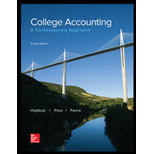
COLLEGE ACCOUNTING (LL)W/ACCESS>CUSTOM<
4th Edition
ISBN: 9781260255157
Author: Haddock
Publisher: MCG CUSTOM
expand_more
expand_more
format_list_bulleted
Concept explainers
Question
Chapter 6, Problem 2.5SRE
To determine
Identify the account that will not appear on the post-closing
Expert Solution & Answer
Want to see the full answer?
Check out a sample textbook solution
Students have asked these similar questions
Recently, Abercrombie & Fitch has been implementing a turnaround strategy since its sales had been falling for the past few years (11% decrease in 2014, 8% in 2015, and just 3% in 2016.) One part of Abercrombie's new strategy has been to abandon its logo-adorned merchandise, replacing it with a subtler look. Abercrombie wrote down $20.6 million of inventory, including logo-adorned merchandise, during the year ending January 30, 2016. Some of this inventory dated back to late 2013. The write-down was net of the amount it would be able to recover selling the inventory at a discount. The write-down is significant; Abercrombie's reported net income after this write-down was $35.6 million. Interestingly, Abercrombie excluded the inventory write-down from its non-GAAP income measures presented to investors; GAAP earnings were also included in the same report. Question: What impact would the write-down of inventory have had on Abercrombie's expenses, Gross margin, and Net income?
Recently, Abercrombie & Fitch has been implementing a turnaround strategy since its sales had been falling for the past few years (11% decrease in 2014, 8% in 2015, and just 3% in 2016.) One part of Abercrombie's new strategy has been to abandon its logo-adorned merchandise, replacing it with a subtler look. Abercrombie wrote down $20.6 million of inventory, including logo-adorned merchandise, during the year ending January 30, 2016. Some of this inventory dated back to late 2013. The write-down was net of the amount it would be able to recover selling the inventory at a discount. The write-down is significant; Abercrombie's reported net income after this write-down was $35.6 million. Interestingly, Abercrombie excluded the inventory write-down from its non-GAAP income measures presented to investors; GAAP earnings were also included in the same report. Question: What impact would the write-down of inventory have had on Abercrombie's assets, Liabilities, and Equity?
Need answer general Accounting
Chapter 6 Solutions
COLLEGE ACCOUNTING (LL)W/ACCESS>CUSTOM<
Ch. 6 - What is the journal entry to close the drawing...Ch. 6 - How is the Income Summary account classified?Ch. 6 - Prob. 1.3SRQCh. 6 - Prob. 1.4SRECh. 6 - Prob. 1.5SRECh. 6 - Prob. 1.6SRACh. 6 - Prob. 2.1SRQCh. 6 - Prob. 2.2SRQCh. 6 - What accounts appear on the post-closing trial...Ch. 6 - Prob. 2.4SRE
Ch. 6 - Prob. 2.5SRECh. 6 - On which financial statement would you find the...Ch. 6 - Prob. 1CSRCh. 6 - A firm has the following expenses: Rent Expense,...Ch. 6 - Prob. 3CSRCh. 6 - What is the last step in the accounting cycle?Ch. 6 - Is the following statement true or false? Why? All...Ch. 6 - Prob. 1DQCh. 6 - Prob. 2DQCh. 6 - What accounts appear on a postclosing trial...Ch. 6 - Prob. 4DQCh. 6 - Prob. 5DQCh. 6 - Prob. 6DQCh. 6 - Prob. 7DQCh. 6 - How is the Income Summary account used in the...Ch. 6 - Briefly describe the flow of data through a simple...Ch. 6 - Prob. 10DQCh. 6 - Prob. 1ECh. 6 - Accounting cycle. Following are the steps in the...Ch. 6 - Prob. 3ECh. 6 - Prob. 4ECh. 6 - Prob. 5ECh. 6 - Prob. 6ECh. 6 - Prob. 7ECh. 6 - Prob. 8ECh. 6 - Prob. 1PACh. 6 - Prob. 2PACh. 6 - Prob. 3PACh. 6 - Prob. 4PACh. 6 - Prob. 1PBCh. 6 - Prob. 2PBCh. 6 - Prob. 3PBCh. 6 - Prob. 4PBCh. 6 - The Trial Balance section of the worksheet for...Ch. 6 - Demetria Davis, the bookkeeper for Home Interiors...Ch. 6 - Prob. 1MFCh. 6 - Prob. 2MFCh. 6 - Why is it important that a firms financial records...Ch. 6 - Prob. 4MFCh. 6 - Prob. 1EDCh. 6 - Prob. 1ICCh. 6 - Prob. 1MPS
Knowledge Booster
Learn more about
Need a deep-dive on the concept behind this application? Look no further. Learn more about this topic, accounting and related others by exploring similar questions and additional content below.Similar questions
arrow_back_ios
SEE MORE QUESTIONS
arrow_forward_ios
Recommended textbooks for you
 College Accounting, Chapters 1-27 (New in Account...AccountingISBN:9781305666160Author:James A. Heintz, Robert W. ParryPublisher:Cengage Learning
College Accounting, Chapters 1-27 (New in Account...AccountingISBN:9781305666160Author:James A. Heintz, Robert W. ParryPublisher:Cengage Learning Financial AccountingAccountingISBN:9781337272124Author:Carl Warren, James M. Reeve, Jonathan DuchacPublisher:Cengage Learning
Financial AccountingAccountingISBN:9781337272124Author:Carl Warren, James M. Reeve, Jonathan DuchacPublisher:Cengage Learning

College Accounting, Chapters 1-27 (New in Account...
Accounting
ISBN:9781305666160
Author:James A. Heintz, Robert W. Parry
Publisher:Cengage Learning

Financial Accounting
Accounting
ISBN:9781337272124
Author:Carl Warren, James M. Reeve, Jonathan Duchac
Publisher:Cengage Learning
The accounting cycle; Author: Alanis Business academy;https://www.youtube.com/watch?v=XTspj8CtzPk;License: Standard YouTube License, CC-BY